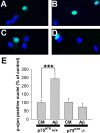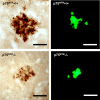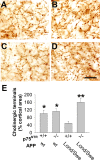The p75 neurotrophin receptor promotes amyloid-beta(1-42)-induced neuritic dystrophy in vitro and in vivo
- PMID: 19710315
- PMCID: PMC2771439
- DOI: 10.1523/JNEUROSCI.0620-09.2009
The p75 neurotrophin receptor promotes amyloid-beta(1-42)-induced neuritic dystrophy in vitro and in vivo
Abstract
Oligomeric forms of amyloid-beta (Abeta) are thought to play a causal role in Alzheimer's disease (AD), and the p75 neurotrophin receptor (p75(NTR)) has been implicated in Abeta-induced neurodegeneration. To further define the functions of p75(NTR) in AD, we examined the interaction of oligomeric Abeta(1-42) with p75(NTR), and the effects of that interaction on neurite integrity in neuron cultures and in a chronic AD mouse model. Atomic force microscopy was used to ascertain the aggregated state of Abeta, and fluorescence resonance energy transfer analysis revealed that Abeta oligomers interact with the extracellular domain of p75(NTR). In vitro studies of Abeta-induced death in neuron cultures isolated from wild-type and p75(NTR-/-) mice, in which the p75(NTR) extracellular domain is deleted, showed reduced sensitivity of mutant cells to Abeta-induced cell death. Interestingly, Abeta-induced neuritic dystrophy and activation of c-Jun, a known mediator of Abeta-induced deleterious signaling, were completely prevented in p75(NTR-/-) neuron cultures. Thy1-hAPP(Lond/Swe) x p75(NTR-/-) mice exhibited significantly diminished hippocampal neuritic dystrophy and complete reversal of basal forebrain cholinergic neurite degeneration relative to those expressing wild-type p75(NTR). Abeta levels were not affected, suggesting that removal of p75(NTR) extracellular domain reduced the ability of excess Abeta to promote neuritic degeneration. These findings indicate that although p75(NTR) likely does not mediate all Abeta effects, it does play a significant role in enabling Abeta-induced neurodegeneration in vitro and in vivo, establishing p75(NTR) as an important therapeutic target for AD.
Figures







Similar articles
-
Beta-amyloid(1-42) induces neuronal death through the p75 neurotrophin receptor.J Neurosci. 2008 Apr 9;28(15):3941-6. doi: 10.1523/JNEUROSCI.0350-08.2008. J Neurosci. 2008. PMID: 18400893 Free PMC article.
-
Neuropathology of mice carrying mutant APP(swe) and/or PS1(M146L) transgenes: alterations in the p75(NTR) cholinergic basal forebrain septohippocampal pathway.Exp Neurol. 2001 Aug;170(2):227-43. doi: 10.1006/exnr.2001.7710. Exp Neurol. 2001. PMID: 11476589
-
Small molecule, non-peptide p75 ligands inhibit Abeta-induced neurodegeneration and synaptic impairment.PLoS One. 2008;3(11):e3604. doi: 10.1371/journal.pone.0003604. Epub 2008 Nov 3. PLoS One. 2008. PMID: 18978948 Free PMC article.
-
The killing of neurons by beta-amyloid peptides, prions, and pro-inflammatory cytokines.Ital J Anat Embryol. 2006 Oct-Dec;111(4):221-46. Ital J Anat Embryol. 2006. PMID: 17385278 Review.
-
Drain of the brain: low-affinity p75 neurotrophin receptor affords a molecular sink for clearance of cortical amyloid β by the cholinergic modulator system.Neurobiol Aging. 2013 Nov;34(11):2517-24. doi: 10.1016/j.neurobiolaging.2013.05.005. Epub 2013 Jun 5. Neurobiol Aging. 2013. PMID: 23747048 Review.
Cited by
-
Small molecule p75NTR ligand prevents cognitive deficits and neurite degeneration in an Alzheimer's mouse model.Neurobiol Aging. 2013 Aug;34(8):2052-63. doi: 10.1016/j.neurobiolaging.2013.02.015. Epub 2013 Mar 29. Neurobiol Aging. 2013. PMID: 23545424 Free PMC article.
-
Non-Amyloid Approaches to Disease Modification for Alzheimer's Disease: An EU/US CTAD Task Force Report.J Prev Alzheimers Dis. 2020;7(3):152-157. doi: 10.14283/jpad.2020.18. Epub 2020 Apr 6. J Prev Alzheimers Dis. 2020. PMID: 32420298 Free PMC article.
-
Cholinotrophic basal forebrain system alterations in 3xTg-AD transgenic mice.Neurobiol Dis. 2011 Feb;41(2):338-52. doi: 10.1016/j.nbd.2010.10.002. Epub 2010 Oct 16. Neurobiol Dis. 2011. PMID: 20937383 Free PMC article.
-
Immunization Against Specific Fragments of Neurotrophin p75 Receptor Protects Forebrain Cholinergic Neurons in the Olfactory Bulbectomized Mice.J Alzheimers Dis. 2016 May 6;53(1):289-301. doi: 10.3233/JAD-160146. J Alzheimers Dis. 2016. PMID: 27163825 Free PMC article.
-
Focused ultrasound delivery of a selective TrkA agonist rescues cholinergic function in a mouse model of Alzheimer's disease.Sci Adv. 2020 Jan 22;6(4):eaax6646. doi: 10.1126/sciadv.aax6646. eCollection 2020 Jan. Sci Adv. 2020. PMID: 32010781 Free PMC article.
References
-
- Amendola J, Durand J. Morphological differences between wild-type and transgenic superoxide dismutase 1 lumbar motoneurons in postnatal mice. J Comp Neurol. 2008;511:329–341. - PubMed
-
- Barker PA. p75NTR is positively promiscuous; novel partners and new insights. Neuron. 2004;42:529–533. - PubMed
-
- Bozyczko-Coyne D, O'Kane TM, Wu ZL, Dobrzanski P, Murthy S, Vaught JL, Scott RW. CEP-1347/KT-7515, an inhibitor of SAPK/JNK pathway activation, promotes survival and blocks multiple events associated with Abeta-induced cortical neuron apoptosis. J Neurochem. 2001;77:849–863. - PubMed
Publication types
MeSH terms
Substances
Grants and funding
LinkOut - more resources
Full Text Sources
Other Literature Sources
Molecular Biology Databases
Research Materials
Miscellaneous
